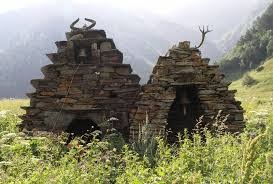What is "Lament in Voice" ?
Lamentation practices in Georgia reach far back to ancient times. The word "Lamentation" means - expression of feelings of grief and sorrow, due to great loss or other tragedy. There are various kinds of lamentation practices all over the world. Ritualized one's, that are embedded in tradition and culture, or more personalized and less traditionally framed one's. In Georgia the lamentation practice was an important component of cultural intactness and was handed over generations through tradition. There where several kinds of different lamentations in different regions, that varied in style, melody and spirit/philosophy.
“Lament in voice” / "ხმით ნატირალი" is a
particular style of lament, that was practiced in the Georgian mountain regions
of Pshavi, Khevsureti and Tusheti. All three regions where known to have the
practice of “lament in voice” at times of loss of members of the village. The
"lament in voice" practice was an integral and key part of the death
rite.
The word “voice” (in "Lament in Voice") would refer to the fact that the lamentation would be expressed in words. A song of sorrow would be spoken through poetical words melodically. The "voice" correlates here to "word". The lamentor would create words of farewell through her voice. That definition was contrasting another kind of lament: "lament in shout", this kind of lament vocalized the grief through cry, howl, shriek,... but not through set words that where sung in rhythm and rhyme. So "lament in voice" meant singing in favor for the dead persons soul through improvised poetry, that was created in the process of the actual on-going death ritual. The song would be sung in a certain melody and rhythm. The lamentor had to take a certain body posture, normally she would lean on the dead persons walking stick while sitting upright, her posture was set. The lamentors in voice where ought to be women. There are only exceptions known of men lamenting.*
The "lamenting in
voice" was understood as a profession, that not anyone was suited for. It required the emotional depth of being profoundly touched by sorrow and loss,
but also the creativity and playfulness with words to be able to express those
feelings through poetry spontaneously.
The sung text, the poetry, was
created in action, in the process of the rite and only then, without
preparation. The context of the death ritual and the connection to the dead
persons soul would be the relational sources from where the "lamentor in voice" would channel the singing. It was not something that generated in her, but that
was created relationally, with the dead soul and with/in the atmosphere.
There where several occasions
when "lamentors in voice" where asked to sing for and with the dead. That would be, before
the dead was buried, after his/her burial, on certain festivities for the dead
throughout the calendar of the year and after one year of the dead persons
death. It was believed that after one year the soul of the dead person would
finally become a part of the ancestors in the other world and complete his journey from this world to the yonder.
The lamentation song was to be sung only once, in the moment and frame of the ritual and never repeated again. Neither should it be repeated by the same person for the same dead at any other moment in time, nor by the same person for another dead persons soul, nor was it to be repeated by another person. Each and every lament was an unique expression and highlighted the evanescent nature of life. It would die with the dead.
*I was told a story by the ethnologist and folklorist Dr. Eter Tataraidze, of an old men in a mountain village of Tusheti who lamented over his dead, as the village was emptying, only his house steamed smoke from the chimney. There where no women to lament over the dead person. So he took the role, as to not let the dead person be sent un-griefed to the otherworld.



Comments
Post a Comment